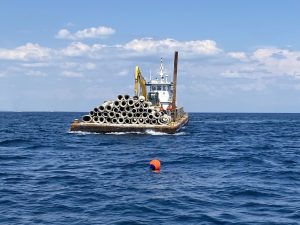Eight New Patch Reef Sites in Bay County
The Artificial Reef Program has a long-standing history of unique artificial reef deployments. From chicken transport units (CTUs) to industrial cable reels, there is something for everyone. Phase I of Bay County’s recent artificial reef project established eight new patch reef sites throughout the the SAARS M permitted area with funding from a RESTORE Act grant.
What is the RESTORE Act?
Congress enacted the Resources and Ecosystems Sustainability, Tourist Opportunities, and Revived Economies of the Gulf Coast States Act in July 2012 after the Deepwater Horizon Oil Spill to bolster community resilience. Five Gulf Coast states (Texas, Mississippi, Louisiana, Alabama and Florida) continue to receive Direct Component funds administered by the U.S. Treasury. The RESTORE grant awarded to Bay County’s Artificial Reef Program is used to address the following:
- Restoration of fisheries, natural resources, marine habitats and ecosystems
- Fisheries monitoring initiatives and the development of a Comprehensive Artificial Reef Plan
- Promotion of local artificial reef sites to rebuild economic loss
- Job creation and promotion of charter activities
- Community education and outreach
- Artificial reef website development and more!
Why concrete?
Concrete has a high success rate as artificial reef material. Interestingly, the chemical composition of concrete is most similar to limestone rock. Due to the presence of lime (calcium carbonate), it has a pH closer to the natural acidity of seawater – which guarantees both durability and stability for artificial reef construction. Quite simply, calcium carbonate is the substance that forms coral reefs!
During production, manufacturers create materials such as bridges, culverts, and pipes with Type I, II, or V Portland cement due to the low water-to-cement ratio to ensure they withstand seawater permeability. When repurposed for artificial reef construction the material is referred to as “secondary-use concrete”.


Prefabricated concrete materials have smooth or textured porous surfaces that attract organisms such as algae, corals and sponges. Secondary-use pipes and culverts were nested inside of one another to increase habitat complexity for various marine fauna. Once these colonial species establish themselves in the concrete, bait fish, crustaceans, and larger pelagics use the material as habitat, spawning grounds, feeding areas, or stops along their migratory routes.
RESTORE Grant: Phase I Patch Reefs
Artificial reef projects are never cookie cutter and come with their fair share of challenges. The RESTORE project was no exception. Bay County obtained over 2000 tons of concrete culverts, pipes and junction boxes from Florida Power and Light (FPL) in 2010. After facing several delays, including Hurricane Michael and COVID-19, the Artificial Reef Program achieved a breakthrough in 2023 with the approval of SAARS M (Small Area Artificial Reef Site M) permitted area. SAARS M measures 1-square nautical mile and is in state waters. The northeastern boundary located 3.1 nautical miles (nm) from St. Andrew Bay Pass, making it readily accessible for recreational use.
The Bay County Board of County Commissioners awarded the project bid to Inland Construction and Engineering (ICE) in July of 2023 for $458,425.00. During Phase I, ICE deployed 1000 tons of material across eight patch reef sites. The locations vary but most reside about 6 nautical miles southwest from St. Andrew Bay Pass in the southern region of SAARS M. These patch reefs improve the availability of nearshore refuge for a diversity of marine species. Completion of Phase I provides Bay County residents with continual opportunities to enjoy nearshore fishing and diving in state waters.
Phase II is scheduled to begin in late fall of 2024. See the table below for patch reef location data.
To explore nearly 800 of Bay County’s artificial reefs, click here!
See you on the water!
Material Placement Data
Please select your preferred file format to view the coordinate data:
 4
4



